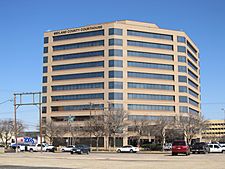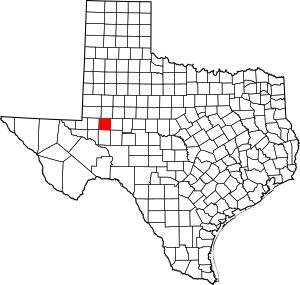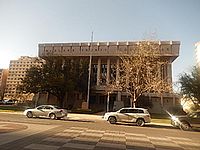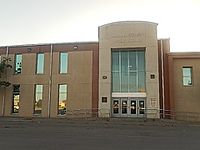Midland County, Texas facts for kids
Quick facts for kids
Midland County
|
||
|---|---|---|

The Midland County Courthouse in Midland
|
||
|
||

Location within the U.S. state of Texas
|
||
 Texas's location within the U.S. |
||
| Country | ||
| State | ||
| Founded | 1885 | |
| Named for | Midland, Texas | |
| Seat | Midland | |
| Largest city | Midland | |
| Area | ||
| • Total | 902 sq mi (2,340 km2) | |
| • Land | 900 sq mi (2,000 km2) | |
| • Water | 1.8 sq mi (5 km2) 0.2% | |
| Population
(2020)
|
||
| • Total | 169,983 | |
| • Density | 188.45/sq mi (72.76/km2) | |
| Time zone | UTC−6 (Central) | |
| • Summer (DST) | UTC−5 (CDT) | |
| Congressional district | 11th | |
Midland County is a county located in the U.S. state of Texas. As of 2020, the population was 169,983. The county seat is Midland. The county is so named for being halfway (midway) between Fort Worth and El Paso on the Texas and Pacific Railway. Midland County is included in the Midland, TX Metropolitan Statistical Area as well as the Midland–Odessa Combined Statistical Area.
Contents
History
In 1968, the county lost before the Supreme Court in Avery v. Midland County which required local districts to be nearly equal. The city of Midland had most of the county's population but only elected one of the five county commissioners, which was found to violate the Fourteenth Amendment.
Geography
According to the U.S. Census Bureau, the county has a total area of 902 square miles (2,340 km2), of which 900 square miles (2,300 km2) is land and 1.8 square miles (4.7 km2) (0.2%) is water. The Spraberry Trend, the third-largest oil field in the United States by remaining reserves, underlies much of the county.
Major highways
 I-20
I-20 Bus. I-20
Bus. I-20 SH 137
SH 137 SH 140
SH 140 SH 158
SH 158 SH 191
SH 191 SH 349 (Nadine and Tom Craddick Highway)
SH 349 (Nadine and Tom Craddick Highway) Loop 40
Loop 40 Loop 250
Loop 250 Loop 268
Loop 268
Adjacent counties
- Martin County (north)
- Glasscock County (east)
- Upton County (south)
- Ector County (west)
- Andrews County (northwest)
- Reagan County (southeast)
Demographics
| Historical population | |||
|---|---|---|---|
| Census | Pop. | %± | |
| 1890 | 1,033 | — | |
| 1900 | 1,741 | 68.5% | |
| 1910 | 3,464 | 99.0% | |
| 1920 | 2,449 | −29.3% | |
| 1930 | 8,005 | 226.9% | |
| 1940 | 11,721 | 46.4% | |
| 1950 | 25,785 | 120.0% | |
| 1960 | 67,717 | 162.6% | |
| 1970 | 65,433 | −3.4% | |
| 1980 | 82,636 | 26.3% | |
| 1990 | 106,611 | 29.0% | |
| 2000 | 116,009 | 8.8% | |
| 2010 | 136,872 | 18.0% | |
| 2020 | 169,983 | 24.2% | |
| U.S. Decennial Census 1850–2010 2010 2020 |
|||
| Race / Ethnicity (NH = Non-Hispanic) | Pop 2000 | Pop 2010 | Pop 2020 | % 2000 | % 2010 | % 2020 |
|---|---|---|---|---|---|---|
| White alone (NH) | 72,015 | 72,822 | 76,487 | 62.08% | 53.20% | 45.00% |
| Black or African American alone (NH) | 7,940 | 8,675 | 10,465 | 6.84% | 6.34% | 6.16% |
| Native American or Alaska Native alone (NH) | 415 | 552 | 686 | 0.36% | 0.40% | 0.40% |
| Asian alone (NH) | 1,040 | 1,639 | 3,891 | 0.90% | 1.20% | 2.29% |
| Pacific Islander alone (NH) | 16 | 42 | 152 | 0.01% | 0.03% | 0.09% |
| Other race alone (NH) | 52 | 211 | 621 | 0.04% | 0.15% | 0.37% |
| Mixed race or Multiracial (NH) | 855 | 1,331 | 4,350 | 0.74% | 0.97% | 2.56% |
| Hispanic or Latino (any race) | 33,676 | 51,600 | 73,331 | 29.03% | 37.70% | 43.14% |
| Total | 116,009 | 136,872 | 169,983 | 100.00% | 100.00% | 100.00% |
As of the census of 2000, there were 116,009 people, 42,745 households, and 30,947 families residing in the county. The population density was 129 people per square mile (50 people/km2). There were 48,060 housing units at an average density of 53 units per square mile (20/km2). The racial makeup of the county was 77.32% White, 6.98% Black or African American, 0.64% Native American, 0.93% Asian, 0.03% Pacific Islander, 12.17% from other races, and 1.92% from two or more races. 29.03% of the population were Hispanic or Latino of any race.
There were 42,745 households, out of which 38.90% had children under the age of 18 living with them, 57.40% were married couples living together, 11.40% had a female householder with no husband present, and 27.60% were non-families. 24.20% of all households were made up of individuals, and 8.60% had someone living alone who was 65 years of age or older. The average household size was 2.68 and the average family size was 3.21.
In the county, the population was spread out, with 30.20% under the age of 18, 8.80% from 18 to 24, 28.40% from 25 to 44, 20.90% from 45 to 64, and 11.60% who were 65 years of age or older. The median age was 34 years. For every 100 females there were 93.40 males. For every 100 females age 18 and over, there were 89.40 males.
The median income for a household in the county was $39,082, and the median income for a family was $47,269. Males had a median income of $36,924 versus $24,708 for females. The per capita income for the county was $20,369. 12.90% of the population and 10.30% of families were below the poverty line. Out of the total people living in poverty, 16.20% are under the age of 18 and 7.90% are 65 or older.
Oil and gas industry
Midland County ranks #1 in the state of Texas for total oil production and #2 for total gas production. Oil and gas data from the Texas Railroad Commission reports 6,602 currently producing wells as of September 2020.
Communities
Cities
- Midland (county seat) (small part in Martin County)
- Odessa (partly in Ector County)
Unincorporated communities
Ghost towns
- Dameron City
- Germania
- Pleasant
- Prairie Lee
- Slaughter
Education
School districts:
- Midland Independent School District
- Greenwood Independent School District
Most areas in the county are within the service area of Midland College; however the Greenwood area is not within the Midland College service area.
See also
 In Spanish: Condado de Midland (Texas) para niños
In Spanish: Condado de Midland (Texas) para niños




